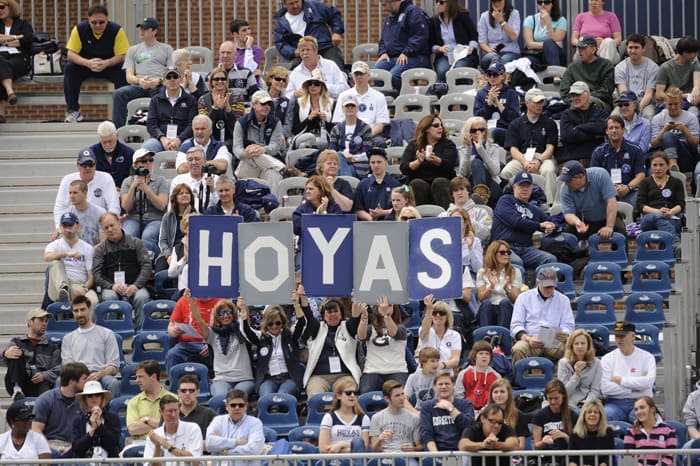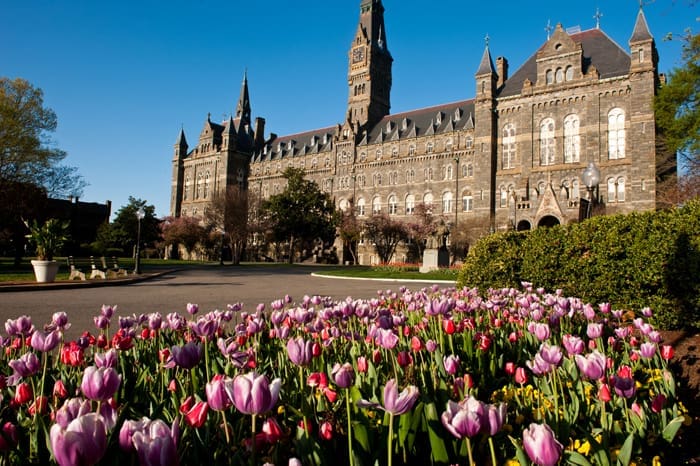
Get stories and expert advice on all things related to college and parenting.

Georgetown is home to a vibrant community of accomplished students, distinguished faculty members, and committed professional staff. Together we use different methods of innovative teaching, including dialogue and new technology, to realize our passion for learning across disciplines, campuses, and continents. Academics at Georgetown are heavily influenced by our Jesuit tradition of cura personalis, or educating the whole person.
The University has more than 12,000 undergraduate and graduate students who take classes at five locations: Main Campus, Medical Center, Law Center, School of Continuing Studies, and the University’s School of Foreign Service-Qatar. Georgetown has a large, diverse workforce that employs more than 5,000 faculty and staff members.
Georgetown’s nine schools offer a wide variety of intellectually rigorous programs designed to prepare students for distinguished careers and guide them toward their intellectual and professional goals.
Georgetown University is the oldest Catholic and Jesuit institution of higher learning in the United States. John Carroll’s founding of Georgetown College coincides with the birth of our nation. In 1789, Carroll secured the deed to 60 acres of land on a hilltop overlooking the village of Georgetown. Classes began in 1792. Within the first year, attendance grew to more than 40 students, from as far away as the West Indies. In 1817, the school awarded its first two bachelor’s degrees.
President:
John J. DeGioia (2001–present)
Size of Main and Medical Campuses:
54 buildings on 104 acres
Motto:
Utraque Unum (both into one)
Undergraduate Student Population:
College: 3,644
School of Foreign Service: 1,438
McDonough School of Business: 1,296
School of Nursing & Health Studies: 457
Total: 6,835
Main Campus Faculty:
Full-time: 869
Part-time: 801
Total: 1,670
Global Georgetown:
125+ different student nationalities
2,500+ international students
15,000+ alumni living abroad
Many years ago, when all Georgetown students were required to study Greek and Latin, the University’s teams were nicknamed “The Stonewallers.” It is suggested that a student, using Greek and Latin terms, started the cheer “Hoya Saxa,” which translates into “What Rocks.” The name proved popular and the term “Hoyas” was eventually adopted for all Georgetown teams.
In 1978, Georgetown began its historic commitment to meet the financial need of every undergraduate who merits admission. The University works to provide eligible students 100 percent of their demonstrated financial need through scholarships, loans, and other forms of assistance. Our practices mean that every eligible undergraduate student, once accepted, can afford to enroll. Each year over half of Georgetown undergraduates receive some form of financial assistance. In 2004, Georgetown launched the Georgetown Scholars Program (GSP). GSP provides low-income and first-generation students with resources to thrive during their time at Georgetown. Today, these resources include mentoring and advising, professional development, wellness and mental health, financial support, and community-building. Since its inception, GSP has graduated over 1,000 students with a 96% graduation rate.
Jack the Bulldog is the University’s official mascot — a well-known figure who is a beloved presence at Georgetown sports events. The class of 1964 brought the first Jack the Bulldog to campus in 1962. According to popular legend, the puppy refused to answer to the name that students gave him (Hoya) and only responded to “Jack.” The current mascot is often seen skateboarding across the court during basketball games.
John J. DeGioia, Ph.D. is the 48th President of Georgetown University. For nearly four decades, Dr. DeGioia has worked to define and strengthen Georgetown University as a premier institution for education and research.
For a virtual map of campus, please visit maps.georgetown.edu.